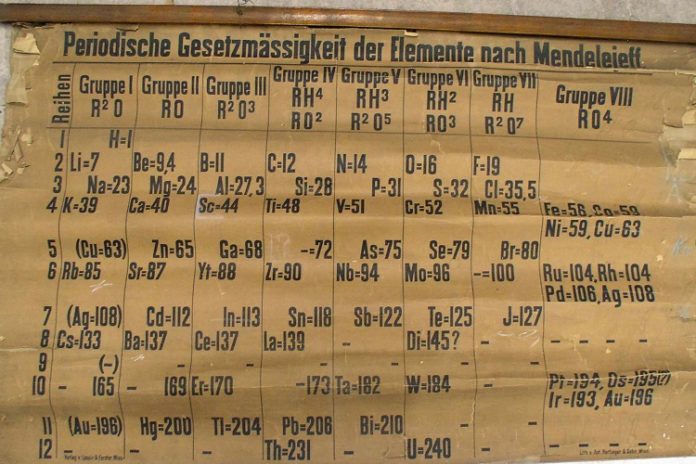A periodic table chart discovered at the University of St Andrews in Scotland is thought to be the oldest in the world.
The chart of elements, dating from 1885, was discovered in the University’s School of Chemistry in 2014 by Dr Alan Aitken during a clear out.
The storage area was full of chemicals, equipment and laboratory paraphernalia that had accumulated since the opening of the chemistry department at its current location in 1968.
Following months of clearing and sorting the various materials a stash of rolled up teaching charts was discovered. Within the collection was a large, extremely fragile periodic table that flaked upon handling. Suggestions that the discovery may be the earliest surviving example of a classroom periodic table in the world meant the document required urgent attention to be authenticated, repaired and restored.
Mendeleev made his famous disclosure on periodicity in 1869, the newly unearthed table was rather similar, but not identical to Mendeleev’s second table of 1871.
However, the St Andrews table was clearly an early specimen. The table is annotated in German, and an inscription at the bottom left – ‘Verlag v. Lenoir & Forster, Wien’ – identifies a scientific printer who operated in Vienna between 1875 and 1888.
Another inscription – ‘Lith. von Ant. Hartinger & Sohn, Wien’ – identifies the chart’s lithographer, who died in 1890. Working with the University’s Special Collections team, the University sought advice from a series of international experts.
Following further investigations, no earlier lecture chart of the table appears to exist. Professor Eric Scerri, an expert on the history of the periodic table based at the University of California, Los Angeles, dated the table to between 1879 and 1886 based on the represented elements. For example, both gallium and scandium, discovered in 1875 and 1879 respectively, are present, while germanium, discovered in 1886, is not.
In view of the table’s age and emerging uniqueness it was important for the teaching chart to be preserved for future generations. The paper support of the chart was fragile and brittle, its rolled format and heavy linen backing contributed to its poor mechanical condition. To make the chart safe for access and use it received a full conservation treatment.
The original periodic table has been rehoused in conservation grade material and is stored in Special Collections’ climate-controlled stores in the University.
Professor David O’Hagan, recent ex-Head of Chemistry at the University of St Andrews, said: “The discovery of the world’s oldest classroom periodic table at the University of St Andrews is remarkable. The table will be available for research and display at the University and we have a number of events planned in 2019, which has been designated international year of the periodic table by the United Nations, to coincide with the 150th anniversary of the table’s creation by Dmitri Mendeleev.”
Gabriel Sewell, Head of Special Collections, University of St Andrews, added: “We are delighted that we now know when the oldest known periodic table chart came to St Andrews to be used in teaching. Thanks to the generosity of the National Manuscripts Conservation Trust, the table has been preserved for current and future generations to enjoy and we look forward to making it accessible to all.”







